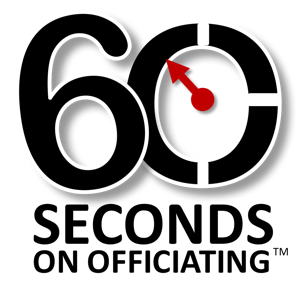
Substitution Subterfuge
- The official nearest the score table beckons THREE substitutes for Team A onto the court during a dead ball.
- In the wave of Team A’s personnel change, FOUR players leave the court for Team A and play mistakenly resumes with Team A competing one player short.
- The coach for Team A is the first to notice the mistake and grabs a player from the bench and directs the player to “get back on the court” immediately.
- That player does not report into the scorer’s table — but just jumps back into the “live ball” play.
If you’re blowing your whistle, are you ruling this action a violation? A technical foul? Or both?
Blowing your whistle to stop play is the best course of action; and the key point to remember if and when you encounter a, “sub on the fly” situation is to quickly and accurately determine if an unfair advantage was gained.
For instance, if during the resumption of play, Team A (A-4) grabbed a defensive rebound and threw a perfect outlet pass to A-5 who is spotted sprinting off the bench towards his/her basket and A-5 then grabs the pass for what will undoubtedly be an uncontested breakaway layup…
In this case, Team A has clearly gained an unfair advantage from their mistake.
The closest official (or an official with confidence in his/her knowledge of the rule!) should blow their whistle immediately, and after a brief conference, charge Team A with a technical foul for this deceitful entrance by A-5 into the game.
However, with a scenario that has a a tardy A-5 frantically running off the bench to join his/her teammates in Team A’s front court is a more benign situation that does not create an unfair advantage and therefore no technical foul should be charged.
Since there is no infraction, no whistle is necessary assuming all of the officials are confident in the rule.
But in most cases, the impulse to blow the whistle and quiet the chaos coming from Team B’s bench and cheering section will win the moment.
So officials should confer quickly and then the Referee provide a brief explanation to the head coach of Team B. Play will resume with a Team A throw in from the point of interruption.
So if this scenario should occur in a future game of yours, just remember your REF 60 ‘paramedic training’ and look for the unfair advantage in the unusual situation…
If there is none, you should remain calm and resume play with no penalty issued.
Rule Reference
NFHS Case Book 10-4-2B and 10-2-5

Does it matter which of team A’s players comes back on to the court? What I mean is, suppose A2, A3, A4 and A5 leave the cours, and A6, A7, and A8 come on the court (one player short). Then, in the hurried confusion, the coach tells bench player A9 (who wasn’t one of the original players on the court) to get on the court. Is the ruling any different if that happens vs. the coach telling A5 to return to the court?
Not that I can tell. Substitute technicals are only punishable if caught before the ball is made live. Since the ball is already live, the improper substitution is instantly made a valid player in the game. A late violation call for the original player having left the playing court unauthorized would still be appropriate, as no substitute had entered for them when they left and there is no time limit expressed for penalizing leaving the court unauthorized in 9-3. It sure beats calling am unsporting foul, given that there was no evidence of an intent to deceive.
it does not matter who comes back on the court as long as they did not gain an unfair advantage.
I disagree. Let coaches “drag their bets” and bring in one sub…then another…then another… Bring in subs whenever they feel like it? No. Coach can spend a time out and fix it. Coach and team can learn and it won’t happen to the crew that follows your game. If not, they’ll run in and out whenever they feel like it.
It’s the administering official’s job to ensure that only as many players leave the playing surface as there are beckoned substitutes, because if more than that do so, a 9-3 violation has occurred. If the official fails to accomplish that, doing what you suggest would be another failure to properly enforce the rules.
The rules don’t say that. If a player left the court having no substitute, his leaving wasn’t authorized and it’s a violation, according to 9-3-3.
In your situation, the option of violation for leaving the playing surface unauthorized seems more appropriate.
During all substitutions the clock is stopped. It is up to the Officials to count players on court before allowing play to continue, especially with such a large substitution.
From a learning standpoint, don’t just assume players are leaving court. I had one player who was going over to talk to coach in a large substitution as this, and I allowed play to resume. Now I had 6 players to 5 because I failed to take my time and count ALL players remaining on floor.
don’t be in a hurry
How about the reverse… 3 players come out for Team A after 4 are beckoned in and play is resumed with 6 on the court. Team A coach yells to A-6 to get onto the bench or even grabs her to pull her to the bench as she goes by. That’s a technical foul, right? To A-6 or to the Team A coach?